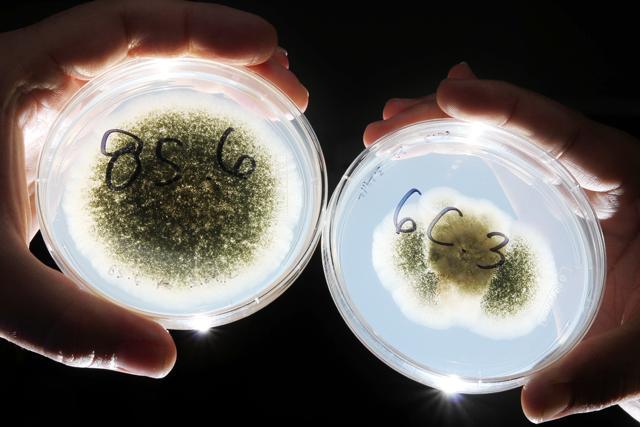Writing grant proposals is a common practice for scientist to finance their labs, but some researchers are looking elsewhere for funding. One of those places is social media.
The College of Agriculture and Life Sciences is hosting a competition to help top researchers publicize their work and award the most popular project deemed by voters. Six finalists were picked to compete in the competition based on merit of their research.
One of the finalists, biochemistry professor Clay Clark and his post-doctoral researcher Sarah Mackenzie are trying to find an affordable way to test alternative drugs to chemotherapy to treat cancer using zebra fish. “We are using zebra fish to screen the drugsproteins -enzymes that trigger cell death. “We have published papers that show that if we activate the proteins in the cancer cells then it kills the cell very efficiently,” Clark said. “Now we are looking for smaller drug compounds that we can use on tumors which will activate the proteins and kill the cells.”
His research involves finding a drug that is less toxic than the current treatments of cancer.
“There is a fine line between killing a cancer cell and killing a human, so we are looking for compounds which are more specific in the terms of what proteins they activate and have lesser toxicity than those drugs,” Clark said.
Ignazio Carbone , associate professor of plant pathology, and graduate student Rodrigo Olarte investigate another facet of cancer research. Their goal is to reduce a fungal toxin, aflatoxin , which is one of the strongest carcinogens and is responsible for hundred of deaths annually.
The aspergillus fungus is a mold that can grown on grain crops, contaminating food and producing alfatoxin , which can cause severe liver failure of liver cancer.
“One of our methods is to apply high density of these sterile fungi females and this should drive down the toxin production,” Carbone said.
By flooding a population with sterile females, new generations cannot proceed to infect crops. Carbone said current methods are not very effective and target only one strain of the problematic mold.
“We are trying to give a new approach to the problem,” Carbone said. “Up until now researchers have worked on targeting one strain-one magic bullet strain which often does not really work.”
Rodrigo Olarte sees the research as a fun project and said the money would help them prove their hypothesis.
“I thought this would be something fun to do,” Orlate said. “It is also about getting our work out as we will be in scientific journals but general audience wouldn’t be there … This money will help us get solid data to push forward for bigger grants.”
In addition to fighting the factors that cause cancer, CALS researchers are looking at neurodegenerative diseases. Jun Ninomiya-Tsuji of the Department of Environmental and Molecular Toxicology is looking at oxidative stress and genes responsible in making sure free radicals from our metabolism and cellular functions can’t damage our cells.
Many epithelial cells, like the cells found in the skin or in the lining of the stomach, will die if exposed to high levels of oxidative stress, which is a good thing when healthy cells will replace them. However, neurons, the cells of our brain and nervous system, will resist cell death, and consequently lose function, bringing rise to diseases like Lou Gehrig’s disease, Parkinson’s and Alzheimer’s. The Ninomiya-Tsuji lab hopes to further study the effects of oxidative stress on nerve cells and how to stimulate neuron genesis.
This opportunity for the finalists has allowed scientists to break out of the lab, engage the public, and use social media to connect science with the people funding it through their tax dollars. In addition to these research labs, independent undergraduate initiatives are also in the mix as another top prize. preliminarily, and then we are injecting cancer cells in the zebra fish embryos, growing tumors in those fish and then administering our drugs to see if [the cancerous tumors] shrink,” Mackenzie said.
Clark said his lab started competing in the symposium after initially submitting a page-and-a-half long description of their research proposal. “The judging committee selected the finalists, and then the finalists made a YouTube video of about two minutes describing what the research is all about,” Clark said. “Those videos have been online for a couple of weeks now. Anyone can access those videos from the competition website and vote for whom they think should win.”
The research areas are diverse and spread out in different areas in life sciences like toxicology, fungi and cancer research. The lab that wins the competition gets $5,000 to help fund the research and becomes Stewards of the Future. Clark’s motivation in researching a cancer cure came from his years of experience in biochemistry and expertise
Two petri dishes of Aspergillus flavus. The right culture contains aflatoxin and is toxic, while the left culture is sectored and is non-toxigenic in the center. Graduate in plant pathology Rodrigo Olarte plans to identify and isolate the natural compound that causes the strand to be non-toxigenic and use it to control aflatoxin. Photo by Tyler Andrews









